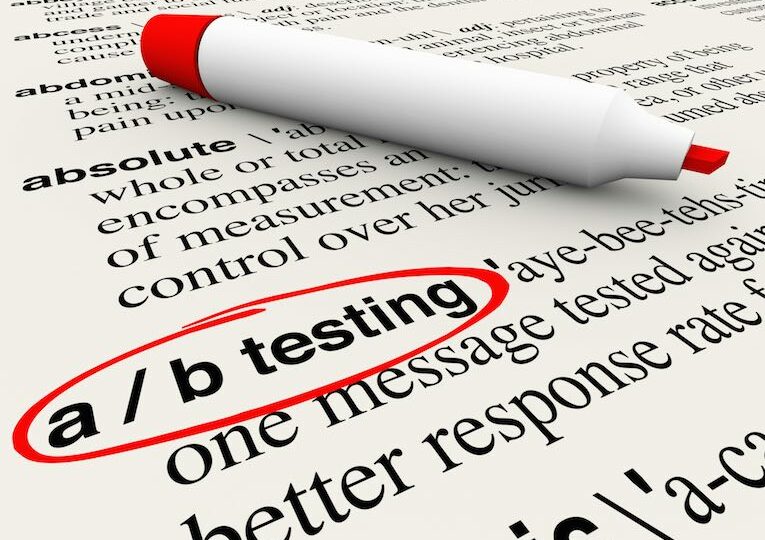In this article, I’ll explain the following:
- Why it’s critical that you test your website, and listen to your audience
- The different types of website feedback loops
- Different types of website testing
- How a series of SMALL incremental increases can create LARGE collective increases downstream
- Things you can test on your website
- How to work out what to test
- Two powerful testing platforms
Here’s why testing and feedback is so important
Website feedback loops and website testing are critical initiatives that any performance-oriented marketer or hands-on business owner must execute if they want to improve the efficiency and return of their digital marketing budget.
Feedback, in the form of situation-relevant qualitative or quantitative data, is used to improve anything – and your website, and subsequent marketing budget Return On Investment is NO different… if you want to improve either, you need “performance” feedback from as many data sources as possible. You need to know what works and what doesn’t work so you can make informed decisions on what to modify to get better performance.
But before I go into that, here’s a mindset trap that many marketers and business owners fall into, when they start out with a new website:
“We forked out a fortune for this website. Why should we test it?”
Yep, I see your logic. It still has the new car smell and it looks like a professional, modern website. But unfortunately it hasn’t been road tested and scientifically adapted to the EFFECTIVE psychological levers of the market it’s serving. Yes, your copywriter might be a freaking prodigy in your chosen industry, but there’s still the “X factor” data that only a real-life market test will produce. In other words, it’s almost impossible for a brand new website to start knocking constant sixes in the very first over (cricket reference), because it hasn’t been tested in the battlefield. Here’s what you need to understand:
Real-life market data MUST influence the evolution of an effective website.
- Only real-life market data will tell you which headlines work, and which don’t.
- Only real-life market data will tell you which emotional triggers work, and which don’t.
- And only real-life market data will tell you what button colour gets more sales or enquiries.
You see what I mean? You need to constantly test and tweak to improve the performance of your digital marketing ecosystem.
More Reasons Why You Should Be Testing
Here’s why it’s so important to collect feedback and conduct testing:
- You’ll reduce marketing waste. Using testing, you’ll learn what campaign components (or landing pages) are ineffectively using your budget. Cull this waste, and you’ve instantly got more budget for the campaign components and landing pages that do work.
- You’ll produce valuable psychological insights into your website visitors, and customers, that can be used in other sales and marketing collateral. Once you understand what drives your prospects and customers to take action online, you’ll be able to use or modify this factual data for other advertising, sales, and marketing initiatives.
- Your market changes over time, and with the right information and knowledge, you can adapt and pivot as required.
- It’s inexpensive and fast to create and launch tests and feedback mechanisms. Website feedback mechanisms (examples below) and testing regimes (examples also below), and learning about your traffic and customers, is not expensive at all. Using the tools I mention below, you could setup a website test in under 60 minutes, that could save you THOUSANDS.
To summarise, website testing and feedback loops are important because:
- You LEARN what sales and marketing collateral works (and what doesn’t)
- You IMPROVE performance of your sales and marketing ecosystem (online and offline)
- You gain valuable INSIGHTS into your customers and your industry.
The different types of website feedback loops
In this context, a website feedback loop it is any piece of data (qualitative OR quantitative) that is returned from your visitors.
Qualitative feedback loops:
- Surveys
- Session tracking
- User Testing tests
- Telephone calls made via the website (using telephone call tracking)
Quantitative feedback loops:
- Data from website analytics platforms like Google Analytics
- Closed loop tracking used to track exactly where leads came from (source, targeting method/keyword, page ID, date, time)
What does this information tell the marketer, and how can it be used?
Qualitative data will tell you:
- The levels of awareness of the traffic – or, if your content is matched to the general level of awareness of your visitors
- The traffic’s satisfaction with the brand’s ability to solve their problem or provide the outcome they desire
- The traffic’s satisfaction with the content on the website
- The traffic’s ability to navigate through the site, and convert into a funnel (or purchase, or enquire etc.)
Quantitative data will tell you:
- Where traffic is coming from, and the effectiveness of each source
- How long different segments stay on the site
- Popular pages, effective pages
Different types of website testing
A/B Testing
A/B testing is the most common form of website testing, and involves the oscillating delivery of two (or more) page or element versions to determine which page or variation produces more desired outcomes. For example, two landing page versions may be tested against each other to determine which landing page version produces the most opt-ins.
The changes to the page or element can be incremental or transformational, depending on the hypotheses of the test – for example, incremental changes might test two different button colours, or transformational might test a whole new page design against another.
A/B tests can also be A/B/C/D/n tests, whereby multiple versions are tested, for example a button colour could be red, green, blue, yellow or grey.
Muiltvariate Testing
Multivariate testing, or “MV” testing is a complex form of AB testing which involves different combinations of elements on a page – for example, differing combinations of 3 stock images, 3 headlines, and 3 button colours (3x3x3=27 different combinations) could be tested to determine the most effective combination.
MV testing requires a high traffic volume, because of the high volume of combinations.
How a series of SMALL incremental increases can create LARGE collective increases downstream
High Level: How A Single, Isolated Test Can Save You $$$
Let me walk you through a basic scenario:
- Let’s say you have a landing page that converts traffic at 5%.
- So, for every 100 users you send to the page, you get 5 conversions.
- Let’s also say it costs you $200 to get 100 users to your page.
- Using this logic, you’re generating 5 conversions every time you spend $200. That’s $40 per conversion.
- If we run a landing page test that increases conversion from 5% to 6%, you’re now generating 6 conversions per $200.
- That’s $34 dollars per conversion, or one additional lead for the same spend.
See what I did there?
Now, assume your monthly budget is $10,000. This means you generate 5000 visitors.
- 5% conversion rate of 5000 visitors: 250 conversions.
- 6% conversion rate of 5000 visitors: 300 conversions.
Using the logic above, increasing your conversion rate from 5% to 6% will generate you 50 more leads for the same spend, or a saving of $2000 (300 conversions at a cost per conversion of $40 = $12,000).
And lastly, let’s assume the split test took you an hour to setup. Your ONE HOUR of work saved you $2000. Nice.
Deep Dive: How A Series Of Tests On A Sales & Marketing Funnel Can Save You Even More
Let’s say you have a sales and marketing funnel, like this:

You can see the conversion rates on the right.
Funnel Experiment #1
Now, let’s say we run an A/B test on the TOFO landing page, which increases landing page conversion rate to 8%:

This then has a knock-on effect which increases sales by 19.99%. Not bad, huh? Assuming all of your funnel metrics remain the same, one small test could impact your revenue considerably.
Funnel Experiment #2
Now, let’s do another A/B test on the BOFO landing page, which increases landing page conversion rate to 30%.

Assuming all funnel metrics stay the same, your sales have increased again.
Funnel Experiment 3
Lastly, with aggressive campaign management, let’s say you reduce your cost per click by 25%.

Check it out – just by incrementally improving different components in your funnel, you’re making 140% more sales.
See what I’m doing here? By installing a series of A/B tests right down your funnel, you’ll make more money from your advertising spend.
Things you can test on your website
Here are example survey questions you can ask:
- Have you found everything you’re looking for on our website?
- Is there anything missing on our website?
- NPS: How likely are you to recommend <BRAND NAME> to a friend?
- What would improve your experience on our site?
- Which do you value more: cheap price or high quality?
Here are hypotheses you can test in an A/B or multivariate test:
Strategy:
- General marketing messaging: pain vs. pleasure, solving problems vs. providing outcomes
- Offer type and complexity
- Persona-centric messaging (eg. messaging that appeals to certain hyper responsive persona types)
- Psychological/emotional triggers
- Discount format etc. 50% off OR buy one get one free
Design:
- General vibe: fun/energetic/serious/etc
- Production value: low-fi/polished/basic/professional/etc
- Layout and whitespace: expanded/squeezed
- Element colours: soft/hard
- Form: Inline/pop-up
- Visual cues: arrows or motion indicators
- Text size & colour
- Stock images
- Button colours
Copy:
- Copy length (long vs. short)
- Features vs. benefits
- Testimonials
- Use of bullet points/numbered lists vs. chunks of text
How to work out what to test
When deciding what to test
Start with the areas that present as the lowest hanging fruit – in other words, areas that need improvement the most, and will give the highest impact. One the low hanging fruit has improved, moved to the next in the priority line.
Questions to ask when establishing what to test:
- Where is money being spent? Start your testing regime by improving the conversion performance of landing pages used by your paid traffic campaigns. Improving any collateral involved in a paid traffic campaign will improve your financial return on investment. Cheaper cost per conversion = more conversions from the same budget.
- Where are the highest value marketing actions occurring? Examine which actions convert your leads into the MOST value – is this at the top of your funnel? Or the bottom? Optimise the mechanism that produces the most VALUE.
- Where are people LEAVING the site? Take a look at Google Analytics and see which pages have the highest abandonment volume (in other words, find out the ‘final’ page(s) your average visitor sees before deciding to leave the site).
- Are incremental changes, or transformational changes required here? This one is difficult for me to explain in a linear blog post, unfortunately. Generally, incremental changes are easier and faster to get off the ground, but will give you smaller upswings or downturns in results. Transformational tests will give you larger wins or losses, but take more effort to establish.
Two powerful testing platforms
Two powerful testing platforms are Visual Website Optimiser (for AB and MV testing) and HotJar (for qualitative website feedback loops like surveys, click maps and mouse recordings).
Google Analytics is also a powerful quantitative tracking tool.
I hope the above provides value to you.
– Ben


